First, have you seen that there is a ‘bonus’ post this week? Yep, the ‘Deco Echo’ blouse from my Art Deco wardrobe is being featured over on the Sew Weekly. I’ll be posting a tutorial on how to make it on Sat or Sun.
Alright, turning our attention to the (suitable Art Deco) term of the week. What is a cloche?
A cloche is a tight fitting hat which comes low over the forehead and at the nape of the neck. It can have a brim or be brimless.
The word comes from the French for bell. The first known use for a hat was in 1882.
Cloche’s are famous as the hat of the 1920s. Their sleek styling matched the shorter, sleeker fashions, and the new bobbed hairstyles allowed a low, tight fitting hat.
1880s origin or not, the cloche hats didn’t pick up steam until the 20th century. A 1908 fashion article credits the invention of the cloche or ‘mushroom’ hat to Mademoiselle Cecile Sorrell “The Queen of French Fashion”. Her innovation must have been quite popular, as bridesmaids were wearing it in New Zealand that very year. Despite her promise to introduce a shape of hat that would make the cloche obsolete, the style was on the rise. In 1910 hats are describes as being “quite cloche in shape”. In 1917 they were considered a type of toque along with turban and mandarin shapes. By 1919 they were one of the leading shapes, though the wide-brimmed portrait hat still reigned supreme.
The early cloche though, is not at all what we envision a cloche hat as looking like. It had a deep crown pulled low, but also a wide picture brim. A 1907 article describes it in depth:
A 1917 ad for ‘full dress’ race wear describes a “A large natural leghorn hat, underlined with black tulle, high cloche crown and drape of shell pink silk velvet; quaint flowers in pastel shades are the sole trimming. A 1918 ad describes the shape as ‘high crowned’.
Throughout the 1920s the brim receded, so that the cloche became the deep, small brimmed hat that the name now refers to.
In addition to the decreasing brim, the cloche went through a number of style changes throughout the 1920s. In 1926 the fashion was for the brim to be turned up (image above). A 1929 story on the “Popularity of the Cloche Hat” extolls its virtues “for their is nothing that suits a woman so well as this type of hat, and mentions “the many types of cloche’, including the new cloche – trimmed round the sides with laurel leaves (sounds like my kind of hat!).
In addition to different styles of cloches, one could get cloches in a wide variety of materials: felt, fabric, straw, and 1928 even saw a brief fashion for wooden cloches – extremely expensive wooden cloches at 10 pounds a hat (though Mmlle Sorrell had not thought 40 pounds too much in 1908!). Another fancy was for matching cloche hats and scarves – quite the thing in 1931.
Whatever they were made of, the cloche was the hat of the 1920s. A 1927 fashion article out of England (as were most fashion articles in early 20th century New Zealand) expresses boredom with the ‘ubiquitous cloche’.
Ubiquitous they may have been, but they weren’t entirely accepted. As late as 1925 they were seen as being a bit risque – the attire of the fast modern woman (one who smoked!), as this cheeky story illustrates.
And not everyone was happy with cloches from an aesthetic perspective. A 1931 fashion article bewailed the effects of brimless hats that do not shield the face from the sun, and the unflattering effect of a bare brow.
By 1935 the heyday of the cloche was over. A fashion article warns that only “an extremely chic woman can look smart in a cloche” , and promotes little hats pushed well back on the head to show the hairline – quite different from the pulled-down, forehead hiding cloche.
Still, having been introduced along with shorter hair, and being so suitable for modern lifestyles (and windy climates!) the cloche would never go away entirely, and has fashionable throughout the 20th century in different guises.
Sources:
O’Hara, Georgina, The Encyclopedia of Fashion: From 1840 to the 1980s. London: Thames and Hudson Ltd. 1986

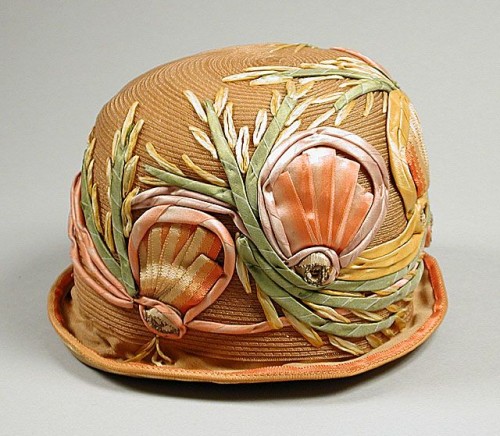
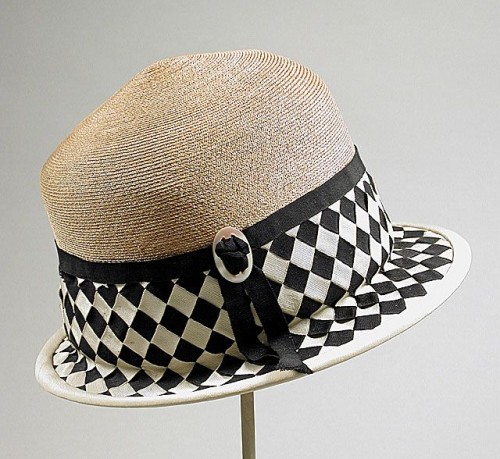
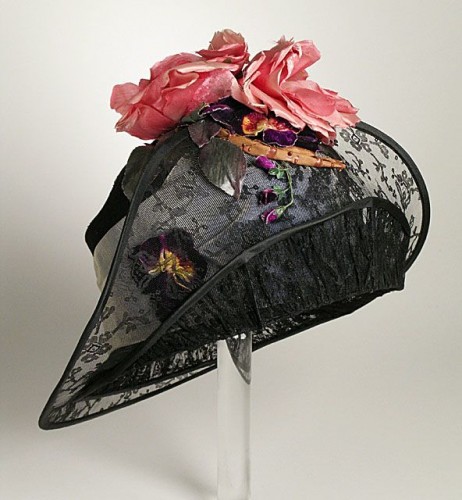

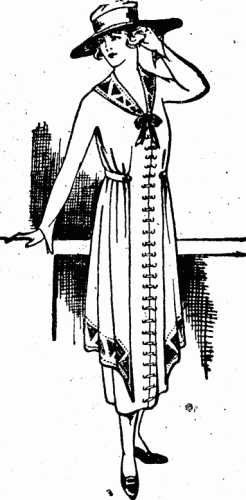

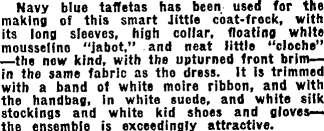
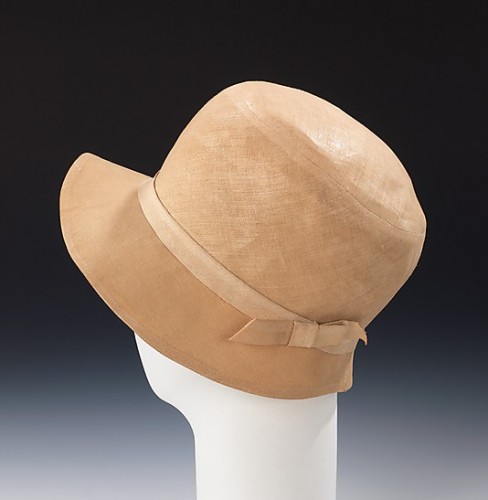

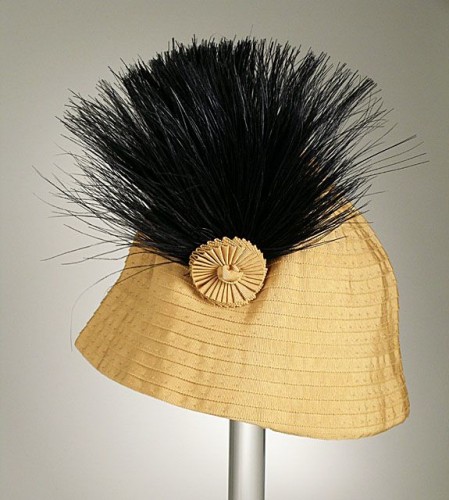
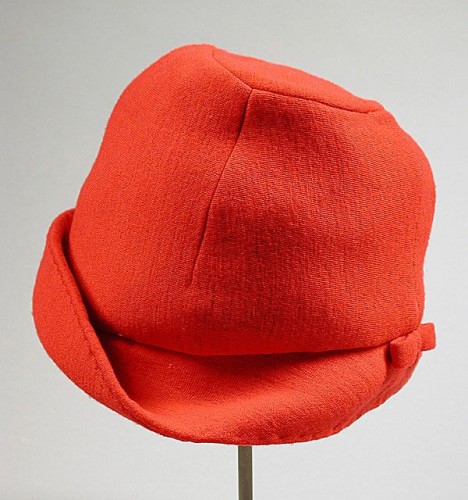
What interesting hats! The straw with the interwoven black and white grosgrain is especially eye-catching.
I’m amused that I have a green and white grosgrain gardening sun hat constructed on the same principles as the Hattie Carnegie, which I bought new last year.
Well done on the Deco Echo blouse!
Cloche hats are my favourite kind of hat. They’re so easy to make, too. It wouldn’t surprise me if the popularity of the cloche had to do with the fact that you can make one at home – to match your dress if you like – without any special equipment. Coincidentally I made one myself last week to go with my copy of your assuit tunic. It has an asymmetrical brim turned up in front, so I suppose it’s a 1926 model.
Hmmmmm…I’ve never thought about that. Do we like cloches because they are make-able?
I love cloches, although I had not thought that they would be related to the brimmed hats on the teens. I think I would have loved the 20s. I cannot thing of another decade that changed the rules so much on fashion and behavior. Anyone?
These are elegant hats that work well for cancer patients who are undergoing chemotherapy, with good coverage. I bought a few from the American Cancer Society for a friend and was so impressed with the style, I then purchased a few for myself. Particularly nice in wool and very easy to add decoration such as a deco jewelry pin or fabric flower.
My favorite kind of hat is a cloche. I have two that my grandmother wore in the 1920s or 30s — how cool is that? I had my high school graduation photos taken in one.
One of your quoted ads said they suited a woman well. I’m not so sure it would do a woman with a chunky face any good. Though I haven’t tried one on, I have a sneaking suspicion it would draw attention to a double chin. But, it would be amazing on a woman with a long slender neck and a cute little chin….just like the photograph and drawing you posted. (And you I might add.)
Such an interesting post – this is one of my favourite hat styles. Would you be interested in a guest post on my blog?
Thank you for the offer, but I’m so busy with blogging and teaching and sewing right now that I’m afraid I don’t have time for guest posts. I’m glad you enjoyed this one!